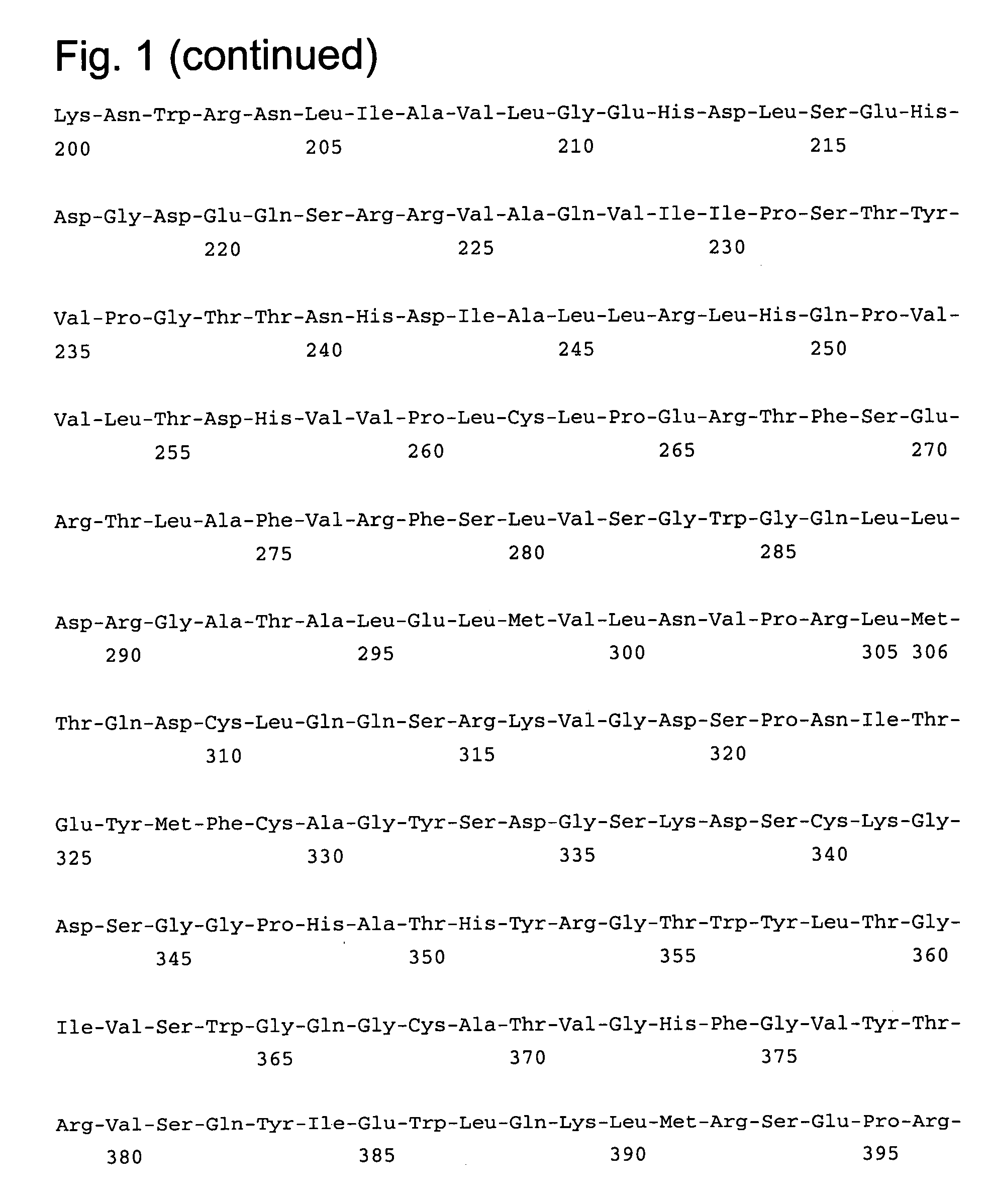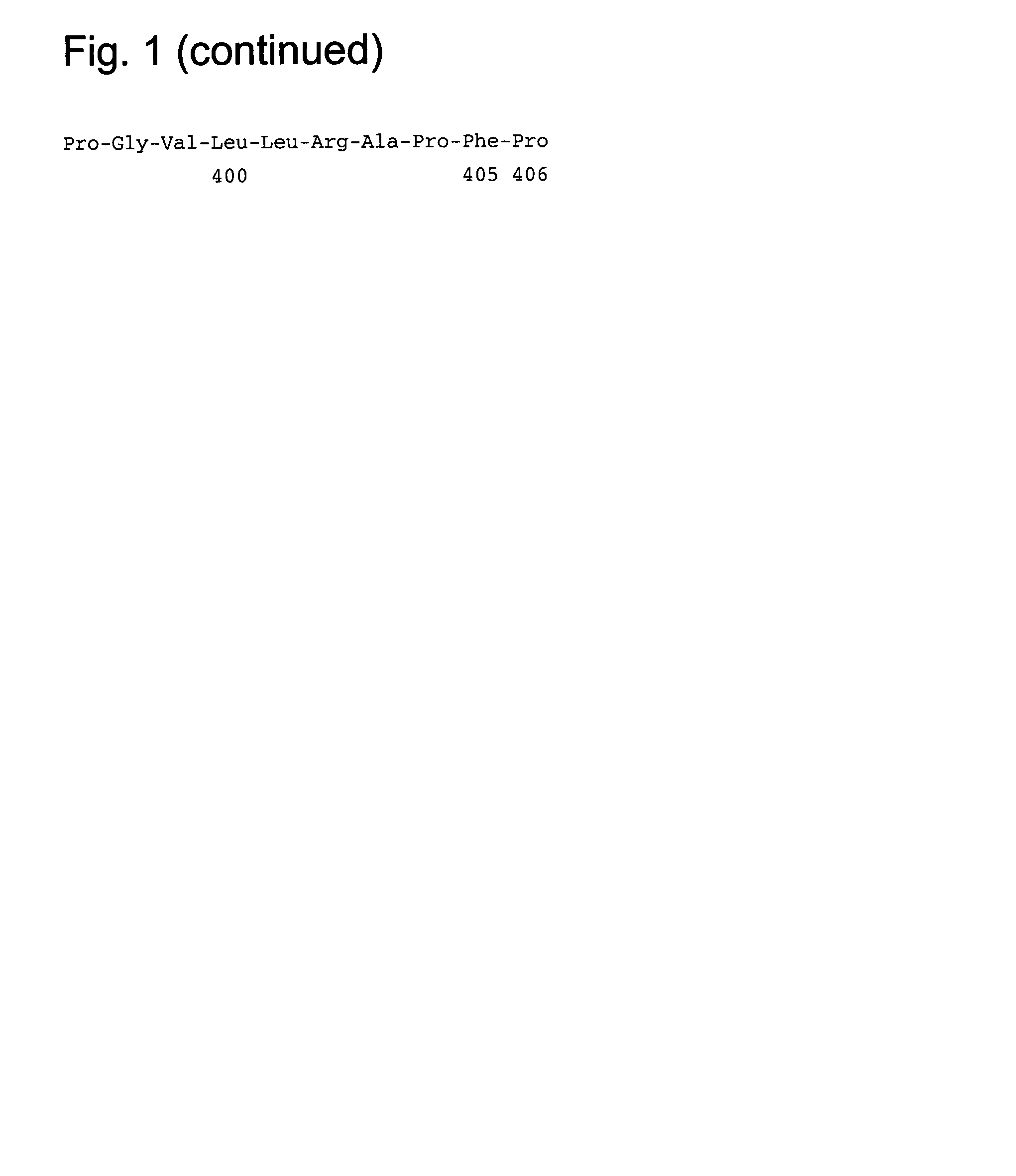Hybrid molecules having Factor VII/VIIa activity
a technology of coagulation factor and hybrid molecules, which is applied in the field of new human coagulation factor vii/viia proteins having coagulant potential/activity, can solve the problems of fibrin clot formation, bleeding is also a major problem, and renders the production of functional proteins in prokaryotic host cells impossibl
- Summary
- Abstract
- Description
- Claims
- Application Information
AI Technical Summary
Benefits of technology
Problems solved by technology
Method used
Image
Examples
example 1
In Vitro Hydrolysis Assay
[0232]Native (wild-type) Factor VIIa and Factor VIIa variants (both hereafter referred to as “Factor VIIa”) are assayed in parallel to directly compare their specific activities. The assay is carried out in a microtiter plate (MaxiSorp, Nunc, Denmark). The chromogenic substrate D-Ile-Pro-Arg-p-nitroanilide (S-2288, Chromogenix, Sweden), final concentration 1 mM, is added to Factor VIIa (final concentration 100 nM) in 50 mM Hepes, pH 7.4, containing 0.1 M NaCl, 5 mM CaCl2 and 1 mg / ml bovine serum albumin. The absorbance at 405 nm is measured continuously in a SpectraMax™ 340 plate reader (Molecular Devices, USA). The absorbance developed during a 20-minute incubation, after subtraction of the absorbance in a blank well containing no enzyme, is used to calculate the ratio between the activities of variant and wild-type Factor VIIa:
Ratio=(A405 nm Factor VIIa variant) / (A405 nm Factor VIIa wild-type).
example 2
In Vitro Proteolysis Assay
[0233]Native (wild-type) Factor VIIa and Factor VIIa variants (both hereafter referred to as “Factor VIIa”) are assayed in parallel to directly compare their specific activities. The assay is carried out in a microtiter plate (MaxiSorp, Nunc, Denmark). Factor VIIa (10 nM) and Factor X (0.8 microM) in 100 microL 50 mM Hepes, pH 7.4, containing 0.1 M NaCl, 5 mM CaCl2 and 1 mg / ml bovine serum albumin, are incubated for 15 min. Factor X cleavage is then stopped by the addition of 50 microL 50 mM Hepes, pH 7.4, containing 0.1 M NaCl, 20 mM EDTA and 1 mg / ml bovine serum albumin. The amount of Factor Xa generated is measured by addition of the chromogenic substrate Z-D-Arg-Gly-Arg-p-nitroanilide (S-2765, Chromogenix, Sweden), final concentration 0.5 mM. The absorbance at 405 nm is measured continuously in a SpectraMax™ 340 plate reader (Molecular Devices, USA). The absorbance developed during 10 minutes, after subtraction of the absorbance in a blank well containi...
example 3
Refolding of the Denatured Hybrid Molecules of the Invention
[0234]Refolding of incorrectly folded hybrid molecules of the invention is described in Sichler K et al., J. Mol. Biol. (2002) 322, 591-603:
[0235]Appropriate folding conditions for denatured FVII is determined by rapid 100-fold dilution of solubilised protein into different folding buffers and incubation for up to 14 days at different temperatures.
[0236]The samples are subsequently dialysed against 20 mM Tris (pH 8.5), 5 mM CaCl2, and the soluble fraction is analysed by non-reducing SDS-PAGE.
[0237]The optimal folding buffer for denatured native FVII was demonstrated to be 1 M L-arginine, 40% ethylene glycol, 50 mM Tris (pH 8.5), 20 mM CaCl2, 1 mM EDTA. The solubilised protein was added repeatedly into the folding buffer, together with 0.5 mM cysteine, resulting in a concentration of 300 mg / l and incubated at 15° C. for ten days.
[0238]It is believed that the same refolding procedure will prove effective with the hybrid molec...
PUM
| Property | Measurement | Unit |
|---|---|---|
| molecular weight | aaaaa | aaaaa |
| molecular weight | aaaaa | aaaaa |
| weight | aaaaa | aaaaa |
Abstract
Description
Claims
Application Information
 Login to View More
Login to View More - R&D
- Intellectual Property
- Life Sciences
- Materials
- Tech Scout
- Unparalleled Data Quality
- Higher Quality Content
- 60% Fewer Hallucinations
Browse by: Latest US Patents, China's latest patents, Technical Efficacy Thesaurus, Application Domain, Technology Topic, Popular Technical Reports.
© 2025 PatSnap. All rights reserved.Legal|Privacy policy|Modern Slavery Act Transparency Statement|Sitemap|About US| Contact US: help@patsnap.com



